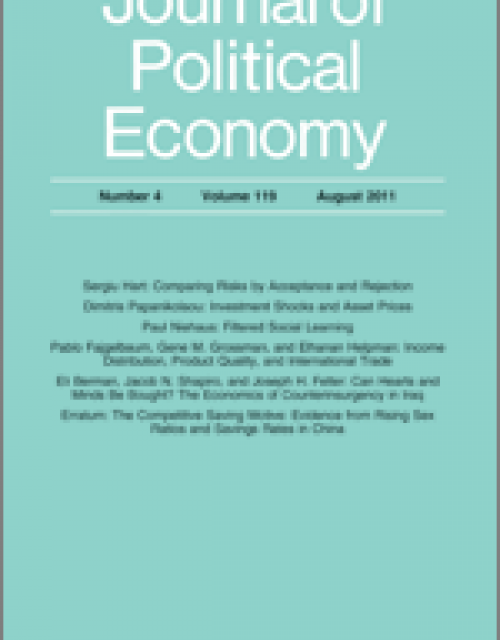Publication records
Subject(s)
Marketing
© 2014 Product Development & Management Association
Volume
32
Journal Pages
424–440
Subject(s)
Economics, politics and business environment
Keyword(s)
Social interactions, identification, incomplete information games
JEL Code(s)
C21, C23, C31, C35, C72, Z13
This paper provides a systematic analysis of identification in linear social interactions models. This is both a theoretical and an econometric exercise as the analysis is linked to a rigorously delineated model of interdependent decisions. We develop an incomplete information game that describes individual choices in the presence of social interactions. The equilibrium strategy profiles are linear. Standard models in the empirical social interactions literature are shown to be exact or approximate special cases of our general framework, which in turn provides a basis for understanding the microeconomic foundations of those models. We consider identification of both endogenous (peer) and contextual social effects under alternative assumptions on a priori information about network structure available to an analyst, and contrast the informational content of individual-level and aggregated data. Finally, we discuss potential ramifications for identification of endogenous group selection and differences between the information sets of analysts and agents.
With permission of the University of Chicago Press
Volume
123
Journal Pages
444–496
Subject(s)
Marketing
Keyword(s)
Goals, product evaluation, positive mood
Negotiating the pursuit of multiple goals often requires making difficult trade-offs between goals. In these situations, consumers can benefit from using products that help them pursue several goals at the same time. But do consumers always prefer these multipurpose products? We propose that consumers’ incidental mood state alters perceptions of products in a multiple-goals context. Four studies demonstrate that being in a positive mood amplifies perceptions of differences between multiple conflicting goals. As a consequence, consumers are less likely to evaluate multipurpose products as being able to serve multiple distinct goals simultaneously. We conclude by discussing implications of these findings for marketers of multipurpose products.
With permission of Elsevier
Volume
25
Journal Pages
296–303
Subject(s)
Entrepreneurship; Technology, R&D management
Keyword(s)
Patent indicators, patent system, product commercialization, pharmaceutical industry, drug development
Patent-based measures are frequently used as indicators in empirical research on innovation and technological change. Currently, there is little evidence as to what extent patent-based indicators relate to product market outcomes. Using a unique dataset that links outcomes from product commercialization in the pharmaceutical industry with detailed patent data, we relate patent-based indicators that capture either an invention’s value or the uncertainty surrounding the patenting process to the outcomes of the product development process. Our findings suggest that the speed of commercialization increases with value but reduces with uncertainty. Using a variety of alternative indicators we derive implications for the use and the proper interpretation of individual measures. Moreover, our study has broader implications as it highlights the detrimental effect of uncertainty on the speed of innovation.
View all ESMT Working Papers in the ESMT Working Paper Series here. ESMT Working Papers are also available via SSRN, RePEc, EconStor, and the German National Library (DNB).
Pages
44
ISSN (Print)
1866–3494
Subject(s)
Marketing
Keyword(s)
Banking, finance, customer service, client centricity, private wealth management, investment banking, customer satisfaction
The financial market crisis has brought the very business models of many banks into question. What lessons should banks take from these events? What consequences will the industry have to face when dealing with clients? These questions are at the center of this book, with contributions from renowned experts and examples from theory and practice. Client commitment – the pursuit of pure customer focus – has become a success factor in many areas of the banking industry. This book sheds light on the theoretical aspects of client commitment and shows how its various facets are being put into practice.
Pages
264
ISBN
978-3-86774-453-9
Subject(s)
Ethics and social responsibility; Marketing
Keyword(s)
Corporate social responsibility, business–nonprofit alliance, nonprofit, Company involvement, company reputation, alliance fit
We investigate the effect of increased company involvement on consumer reactions to companies and nonprofits in business–nonprofit alliances to show that consumer reactions to the two parties in such alliances can, under certain conditions, diverge from each other. Specifically, we show that increased company involvement results in more positive consumer attitudes toward companies with low (but not high) reputation, while it leads to more positive consumer attitude toward nonprofits that partner with companies with high (but not low) reputation. Furthermore, we demonstrate that these effects are independent of the perceived fit between the company and nonprofit forming the alliance. Finally, we show that when consumers elaborate on company motives, the observed effects of increased company involvement are mitigated.
© Springer Science+Business Media New York 2013. With permission of Springer
Volume
26
Journal Pages
29–42
Subject(s)
Marketing
Secondary Title
Client centricity: Relationship management in banking
Pages
73–90
ISBN
978-3-86774-453-9
Subject(s)
Technology, R&D management
Keyword(s)
Knowledge-based view, patents, outsourcing
Secondary Title
The economics of outsourcing
Pages
696–715
ISBN
9781783471805
Subject(s)
Ethics and social responsibility
Keyword(s)
Corporate social responsibility, corporate crisis, insulation, crisis management
Many companies today believe that corporate social responsibility (CSR) acts as a reservoir of goodwill, insulating the firm from the negative impacts of a crisis. Yet, the impact of CSR on public reaction to corporate crises is more complex. Drawing on research on stakeholder reactions to CSR and—more specifically—corporate crises, we present a contingent framework for understanding the roles of CSR in corporate crises and how to manage it. This framework posits that CSR plays four important roles: it (1) increases stakeholders’ attention to crises, (2) affects blame attributions, (3) raises expectations, and (4) changes stakeholders’ evaluations of crisis situations. Several factors underlying these roles are also discussed. Overall, this article underscores that while CSR may insulate companies and mitigate stakeholders’ negative responses in some cases, in others it may actually lead to the opposite effect, amplifying the negative impact of a crisis. The article ends with a brief discussion of the implications of our framework for effective crisis management strategies in the age of CSR.
With permission of Elsevier
Volume
58
Journal Pages
183–192
Subject(s)
Finance, accounting and corporate governance
Keyword(s)
LIBOR market model, jump diffusion,Markov switching, Heath-Jarrow-Morton model, pricing, parameter estimation
JEL Code(s)
C02, C60, G12, G13
Volume
15
Journal Pages
455–476


